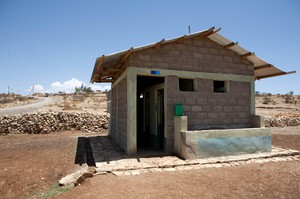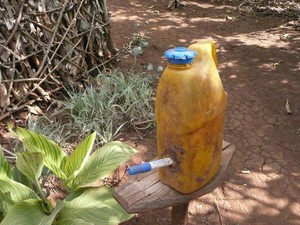In Study Session 2, you learned about the effects of poor sanitation and waste management. List some of the potential impacts on schools.
The possible answers include health problems, impacts on attendance (especially for girls) and achievement, and pollution of the school environment.
Poor school sanitation and waste management create many problems:
Conversely good sanitation and waste management in schools means that:
You have been a school student at some time in the past. What were the components of school health services in your time?
You might have various memories of events. Your classroom teacher might have checked your personal hygiene. You might have learned about the common bacterial eye infection trachoma and face-washing in science class. You were probably reminded to use the latrine properly and to wash your hands afterwards.
In low-income countries, many schools do not have water supply or latrines at all, or if they do, they may not have handwashing facilities. Even in schools that do have facilities, these are frequently not maintained or kept clean, or may be kept locked.
The provision of improved latrines with attached urinals in schools is extremely important. Many of the design requirements are similar to those for domestic latrines that you learned about in Study Session 5. For example, latrines must be located a safe distance from water sources. Standard guidance for schools includes the following additional requirements:

Figure 12.1 Latrine with handrails and raised position to support disabled students.
In Study Session 5, you learned of the different types of latrine technologies. Which of them do you think could be used in schools?
Schools could use improved pit latrines or VIP latrines (with lined pit, concrete slab and vent pipe). They could use composting toilets or urine-diverting toilets if they had the necessary equipment, staff and procedures in place. Pour-flush latrines or cistern-flush toilets are also possible if there was access to water and connection to a septic tank or sewer.
Handwashing facilities need to be constructed very close to all latrines and urinal blocks for use by students and teachers. The minimum requirement is a basin, a way to pour or run water over the hands, and soap. There are many models for handwashing stations: water taps with basins or troughs (Figure 12.2); buckets of water; and tippy taps (Figure 12.3). Remember that soap should always be available.
The greywater that results from the handwashing must be drained to a soakaway pit or septic tank (or sewer, if available). If there is enough space, it is possible to use greywater in a school garden to irrigate the vegetables.

Figure 12.2 New school latrine block with handwashing facilities.

Figure 12.3 Tippy taps are easily and cheaply made from an old plastic container and the plastic tube from a used pen.
Menstrual hygiene management (MHM) is the management of monthly menstrual periods by women and adolescent girls using a clean material to absorb or collect menstrual blood. It is essential that this material can be changed in privacy and as often as necessary for the duration of the menstrual period. MHM includes using soap and water for washing the body as required and having access to facilities to dispose of or wash used menstrual pads and towels.
In many parts of the developing world, MHM is one of the critical challenges facing adolescent schoolgirls. Poor facilities for MHM has been shown to cause worry and humiliation, contribute to monthly absenteeism and lead to poor performance (Sommer et al, 2013).
The following facilities should be provided for adequate MHM provision in schools:
Schools should practise the 3 Rs of waste management. Since a large proportion of schools’ waste is paper, it may be possible to collect the paper for recycling by the paper industries. Ideally, each classroom should have separate bins for the waste that is collected for recycling and for the non-recyclable waste. Children should be encouraged to keep the classrooms and other areas clean and take pride in a clean and hygienic school environment. There should also be bins in teachers’ rooms and the playground. It is helpful to encourage a culture in schools that makes dropping litter unacceptable and helps children to develop the habit of putting waste in a bin.
If the school has its own waste disposal pit, this should be in an isolated area and fenced off to prevent access by the children. The waste should be covered with soil after placing it in the pit to reduce scavenging by rodents and birds. There could also be chemical wastes from school laboratories. These should be stored separately in a secure location for collection and disposal (the local authority or possibly a local hospital may be able to collect this waste).